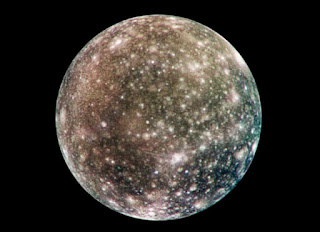Carbon dioxide gas found throughout the atmosphere of Callisto hints it has a complex carbon cycle – akin to the one which on Earth helps to sustain life
 |
| The surface of Jupiter's moons Callisto is scarred with impact craters and it's atmosphere holds carbon dioxide gas (Credit: NASA/JPL/DRL) |
Astronomers have spotted gaseous carbon dioxide across the atmosphere of Jupiter’s second-largest moon, Callisto, hinting that it might have a much more complex carbon cycle than we thought. On Earth, the carbon cycle helps to sustain a stable climate.
Callisto is one of the solar system’s oldest objects, having formed some 4.5 billion years ago around Jupiter. It is also one of the most battered objects, with a surface blanketed by craters.
Space probes over the past few decades have revealed that the moon is mostly covered with ice, mixed with large amounts of solid CO2. In 1997, the Galileo probe spotted some hints that there may also be gaseous CO2 in Callisto’s atmosphere.
Now, Richard Cartwright at Johns Hopkins University in Maryland and his colleagues have confirmed the presence of CO2 gas on the moon.
The researchers analysed data from the James Webb Space Telescope’s near-infrared spectrograph instrument, which disperses light from objects such as moons and planets into a spectrum that tells us their chemical composition.
They found that CO2 was distributed all around Callisto’s atmosphere, with higher concentrations towards the moon’s south pole. The main gas in the atmosphere is oxygen, however.
One explanation for the presence of CO2 gas could be that occasional meteor impacts or Jupiter’s powerful radiation belt are disturbing the moon’s surface, allowing the gas to seep out of the crust and into the atmosphere, says Cartwright. Another possibility is that energetic photons react with the solid CO2 on the surface to produce the gas.
“There’s debate whether the CO2 comes from Callisto’s interior, or if it is being made on the surface,” he says. “The answer is probably both.”
“This looks an intriguing study which might indicate a carbon cycle on Callisto,” says Andrew Coates at University College London. “This is certainly something to be followed up by the ESA [European Space Agency] JUICE and NASA Europa Clipper missions.”
If Callisto has a carbon cycle, it could mean that other large moons of Jupiter have them too. In the case of the moon Europa, this would be yet another tantalising sign that life could be hosted there.
The telescope data also included signs of chemical compounds that contained carbon and nitrogen atoms attached to one another with triple bonds. These could be traces of complex organic molecules that may have been transported by meteoroids both to Callisto and early Earth.
“This is really significant for the Jupiter system because nitrogen has been hard to pin down,” says Cartwright. “We don’t see this on Ganymede or on Europa, so we can use Callisto as an avenue for understanding nitrogen chemistry on the other moons.”
Reference
arXiv DOI: 10.48550/arXiv.2401.17236
